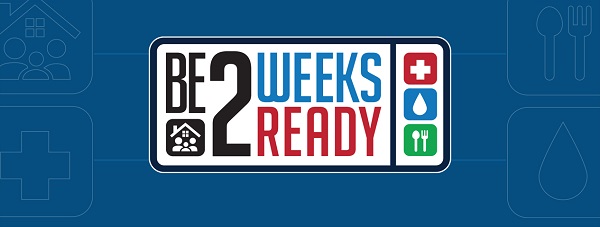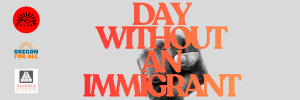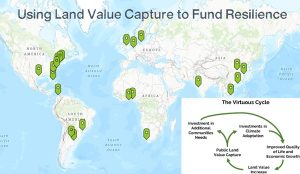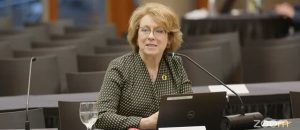Oregon releases ‘Be 2 Weeks Ready’ preparedness program, offers training
9 min read
Oregon’s Department of Emergency Management rolls out its new community preparedness program. It’s called ‘Be 2 Weeks Ready.’ At the FEMA Region 10 webinar on June 20:
Kayla Thompson (ODEM Community Preparedness Coordinator): My name is Kayla Thompson. I’m the Community Preparedness Coordinator at the Oregon Department of Emergency Management. And in my role, I oversee our new preparedness program, Be 2 Weeks Ready.
[00:00:23] Today I’ll talk about why we need a program like ‘Be 2 Weeks Ready.’ This program is designed to empower you to have enough supplies to be self-sufficient for two weeks following a major disaster. The inspiration for this program came from the Cascadia subduction zone earthquake, but it applies to any sort of disaster that disrupts your everyday life.
[00:00:47] So why do we need a program like this? Well, as we continue to experience more and more disasters, research has shown that just having a go bag with a few days’ worth of supplies isn’t enough anymore. In the event of a large-scale disaster like Cascadia, help will not be readily available. You are the help until help arrives.
[00:01:08] Having at least two weeks’ worth of supplies, maybe four to six if you live on the coast, will help you be self-sufficient. And by taking the steps outlined in this program, you’ll be prepared for other disasters, such as ice storms or wildfires.
[00:01:24] So ‘Be 2 Weeks Ready’ is a community-centered and activity-based program. There are eight units, along with three to four activities per unit. And these make up what we call the ‘Be 2 Weeks Ready Toolkit.’
[00:01:40] You can access the toolkit on your own at any time by going to our website, Oregon.gov/OEM/ Be2WeeksReady.
[00:01:51] In this program, we use the word community a lot. For this program, a community is any group of people who spends time together. It doesn’t just have to be your neighbors. Our hope is that people will learn this material within their social circles, because we don’t know where we’ll be when a disaster happens.
[00:02:11] So the more of our social circles who have this level of preparedness, the easier it will be to bounce back. You’ll learn who has extra resources, extra skills, but also who may need some extra assistance in the event of a disaster.
[00:02:26] So with communities. Communities could be co-workers at a job, parents and guardians of students in a school, neighborhood associations, faith-based groups, or even students in a college dorm.
[00:02:40] Again, this program can be done individually, but we’ve added that community structure. So it starts with the Community Preparedness Coordinator at OEM, which is me. I manage the program and I support the program coordinators. The program coordinators are individuals who are in an outreach or a training position and want to bring this program to their community.
[00:03:06] They then select community hosts who are people within their community who want to teach this information to others.
[00:03:13] And lastly, the communities are the groups of people who want to learn the preparedness information.
[00:03:19] So some examples of this. First, we have a hospital on the coast. The training coordinator wants to have all their staff and their households prepared so they can respond to the hospital following a major disaster.
[00:03:34] The training coordinator is the program coordinator and the community hosts are one staff member in each department in the hospital. And then the community is the 700 staff at the hospital. So this is a larger scale example.
[00:03:50] A smaller scale example: You have a local parish leader who wants to teach all the parishioners how to have two weeks’ worth of supplies. In this situation, she is also the community host, so the person teaching the information, because she wants to teach the information to the leadership first to get their support. So once they go through all the eight units, then they will teach it to the rest of the parish. So this is an example of how this program can be adjusted to your community’s needs and delivered at whatever pace is appropriate.
[00:04:25] If you’re meeting once a week, once a month, once a quarter, that’s fine. It’s whatever is the best way for your community to learn it.
[00:04:36] So how do you become one of the program coordinators? It’s pretty simple. First, you attend a virtual four-hour training with me, where I teach you the purpose of the program, talk about how you can build outreach and partnerships, you set some goals for your program, and then we review the entire toolkit together.
[00:04:55] After that, you’re added to an email group and invited to a monthly meeting where you can ask questions and network with other program coordinators. It’s also an opportunity for me to provide any updates or additional resources that I have.
[00:05:11] We’ve already had 101 people from various organizations and community groups across the state complete the first round of this training. We did it this past March and April, so gave them a couple months’ head start to plan their outreach, set their goals before the program officially launched this week.
[00:05:31] So that’s why we have the program, why we need it, how the program works. Again, you can access it on your own, but hopefully you will bring it to your community and learn together as a group in person.
[00:05:45] John Q: Kayla Thompson from the Oregon Department of Emergency Management, described the eight units of the new preparedness program, ‘Be 2 Weeks Ready.’
[00:05:53] Kayla Thompson (ODEM Preparedness Coordinator): The first one is called ‘Preparing to Prepare.’ This is our shortest unit and it leans heavily on the activities. So in the unit you learn how to mentally prepare for living through a disaster. How might it feel if it’s 3 a.m, it’s dark, you’re woken up to your bed shaking, and your living space being damaged?
[00:06:18] And then you also take a baseline assessment of your preparedness plan. Do you have extra food? Do you have extra water? Do you know how you will communicate with the members of your household, if you are not at home during a disaster? Things like that.
[00:06:31] And the activities include journaling two weeks of a disaster scenario, so you get a different prompt, you get 14 prompts. You track your food and water for everyone in your household, write words of encouragement to yourself, and then practice some mindfulness.
[00:06:46] The next unit is Unit 2: Your Emergency Plan. In this unit, you’ll learn what your household needs in an emergency, how to create that communication plan, how to sign up for alerts, and the importance of actually practicing your plan. The activities include building your plan, building your emergency stash, cataloging your belongings, and then practicing protective actions such as drop, cover, and hold on.
[00:07:15] Then we have Unit 3, that’s the Food Plan. This is probably one of the most overwhelming parts of emergency preparedness, but in this unit, we break it down into cost effective ways to build a supply, how you can safely store your extra food, and also alternative ways to cook. The activities include creating your food plan, different ways to grow your own food, and even building a pizza box solar oven.
[00:07:42] Next is Unit 4: The Water Plan. In this unit, you’ll learn how much water your household needs. How to store it, and the various ways that you can sanitize it. The activities give you a chance to practice this, as well as how to find other sources of water in your home, such as removing water from your water heater tank.
[00:08:03] Then we have Unit 5, Waste and Hygiene Plan. This unit focuses on how to stay safe and healthy during a disaster when you don’t have running water. We also cover how to dispose of pet and human waste, as well as different ways of doing laundry. So in this unit with the activities, you’ll build a handwashing and a dishwashing station, prepare a two bucket toilet system, and make an emergency washing machine.
[00:08:29] Next is Unit 6: The Shelter Plan. You’ll learn about identifying the potential hazards where you live, you know, living on the coast has different hazards than living in the city, how to make your living space safer, and the steps that you can take immediately following a disaster, such as an earthquake.
[00:08:47] The activities include a home hazard hunt. So going around your living space and identifying ways to make it safer, you know, making sure mirrors are secured to the wall, heavy furniture is locked down, how to shut off your utilities, and then, what you can put in a go bag.
[00:09:03] Next is Unit 7: First Aid. This is a pretty short unit. It talks about how you can build a first aid kit, recommended supplies, and also how you can build it with your community, so buying items in bulk and splitting them amongst everybody, as well as some very basic first aid, so making a T-shirt sling, wrapping an ankle, or splintering a finger.
[00:09:28] One of the activities is encouraging you to try different first aid classes offered in your area such as CPR, and also an activity where you practice those simple first aid techniques, such as wrapping an ankle or making the T-shirt sling.
[00:09:42] And then lastly, we have Unit 8: Emergency Management. So this unit gives an overview of what a local emergency manager, Oregon Department of Emergency Management, and FEMA do when a disaster happens and includes activities on how to engage with your local emergency manager and be a part of your community’s overall preparedness.
[00:10:03] So that’s reaching out to your neighbors, talking to people about the program, even possibly joining your Community Emergency Response Team, your local CERT program. Those are the eight units in the toolkit. Again, you can look at them on your own, but hopefully you will bring it to your community group.
[00:10:22] John Q: The program is available in multiple languages.
[00:10:26] Kayla Thompson (ODEM Preparedness Coordinator): And one part of this program, it’s very important that it is as accessible as possible. So the toolkit is online, and it is available in English, Spanish, Vietnamese, Chinese, and Russian. These are the top five languages spoken in Oregon, so that’s why we started with those.
And then we’re also so close to being done with our American Sign Language videos, which we are very excited to have available. So those are just about done and will be posted on our website in mid-July.
[00:11:00] And then later this summer, we’ll be working on another round of language accessibility by adding formats for low vision needs and formats that are compatible with screen readers and Braille printers. The next language we’ll be translating into is Korean, and then we will continue to translate into other languages as the program goes on.
[00:11:21] So: learn about why we have this program, what the program is, the community structure, each section of the toolkit. So how do you get involved? It’s pretty easy. So, you can go online, Oregon.gov/OEM/Be2WeeksReady, and look at the toolkit on there.
[00:11:39] Or if you want to become a program coordinator yourself, and bring the program to your area, or you would like to find a community host near you that could come and present to your group, you can email community.preparedness@oem.oregon.gov and we will be hosting program coordinator trainings every quarter. They’re all on Zoom, they’re free, they’re offered on an ongoing basis. So we’ll do one in July and August and then October, November.
[00:12:11] So a couple trainings every quarter. If we need to add more trainings, we will, but we will be offering these on an ongoing basis.
[00:12:19] So just remember, you’re probably more prepared than you think. As you go through this toolkit and you read the different units and you go through the activities, you’ll probably find that you already have some of the supplies and you’ve already taken some of the steps to be more prepared. This program just puts all the information and those checklists in one spot so you can see what else that you need to do to be better prepared.
[00:12:43] John Q: Kayla recognized the ODEM staff members who produced the extensive preparedness materials.
[00:12:51] Kayla Thompson (ODEM Preparedness Coordinator): …Althea Rizzo, Randy Hamar, C. Crabb, Zachary Stella. We officially launched the program on our website Monday, June 17. So it’s great to finally be able to share their hard work with you all.
[00:13:05] John Q: Download the toolkit today, and consider serving as a community host to bring these materials to your social group. The next training is coming up in July. To learn more, see the website, Be 2 Weeks Ready.



